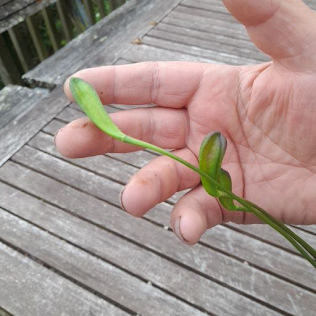The book Cross-cultural Ethnobotany of North East India (1) says the tender shoot of Hedychium coccineum (orange gingerlily) is eaten raw or cooked by the Anals of Chandel District and is cultivated in kitchen gardens for this purpose. There are also a few brief mentions of this use online (2,3). There seem to be no record of this use in the West even though the plant is grown in gardens as an ornamental.
I've tried the shoots, they have a mild ginger flavor, not at all overpowering, good chopped up added to a stir fry. They have no fibers and a pleasant crisp texture. You have to peel away the inedible outer layer, this is pretty easy and quick.
I tried what I think is the large variety Hedychium coccinium var angustifolium (narrow leaf ginger), purchased from Coast Palms and Cycads (New Zealand), sold as Hedychium coccinium "Lizzie". They have used the same photo on their website for this plant as used by the Pacific Bulb Society for var angustifolium. It also matches the description of angustifolium given by Branney (4). Mine have not flowered yet so I can't compare them to the photos directly.
It is not clear it is this large variety that is eaten in Asia but it tastes fine. I read somewhere there is no known toxicity in Zingiberaceae but can't find that reference now. Angustifolium is now considered a synonym of coccinium.
The plant grows well in Wellington, NZ, (zone 9). It got very tatty in winter, basically deciduous, but grew back fine in spring. It does not mind heavy clay soil and is fine in part shade. Angustifolium is probably too big for small gardens, about 2 m tall.
I'm not yet sure how productive it is, presumably it is reasonably productive if cultivated in kitchen gardens in India for food.
References.
1) Cross-cultural Ethnobotany of North East India. A Saklani. S K Jain 1994.
2) An ethnobotanical note on wild edible plants of Upper Eastern Himalaya, India.
G. Murtem¹ and Pradeep Chaudhry
https://www.researchgate.net/publication/305112551_An_ethnobotanical_note_on_wild_edible_plants_of_Upper_Eastern_Himalaya_India
3) Monpa, memory, and change: an ethnobotanical study of plant use in Mêdog County, South-east Tibet, China
https://ethnobiomed.biomedcentral.com/articles/10.1186/s13002-020-0355-7
4) Hardy Gingers. T.M.E Branney. Royal Horticultural Society. 2005.


